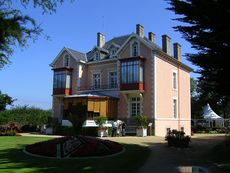Christian Dior
| Christian Dior | |
|---|---|
| Born | 21 January 1905 Granville, Manche, Basse-Normandie, France |
| Died | 24 October 1957 (aged 52) Montecatini, Italy |
| Nationality | French |
| Labels | Christian Dior |

Christian Dior (21 January 1905, Granville, Manche – 24 October 1957), was an influential French fashion designer, best known as the founder of one of the world's top fashion houses, also called Christian Dior.
Contents |
Life
Christian Dior was born in Granville, Manche, a seaside town on the coast of France. His family, whose fortune was derived from the manufacture of fertilizer, had hopes he would become a diplomat, but Dior only wished to be involved in mostly fashion, but sketching as well. To make money, he sold his fashion sketches outside for about 10 cents each. After leaving school he received money from his father so that in 1928 he could open a small art gallery, where he sold art by the likes of Pablo Picasso.
After a family financial disaster that resulted in his father losing his business, Dior was forced to close the gallery. From the 30's to the 40's he worked with Robert Piguet until being called up for military service. In 1942, having left the Army, Dior joined the fashion house of Lucien Lelong, where he and Pierre Balmain were the primary designers. For the duration of World War II, Christian Dior dressed the wives of the Nazi officers and French collaborators. On 8 October 1946 Dior founded his own fashion house, backed by Marcel Boussac, the cotton-fabric magnate.
The actual name of the line of his first collection, presented in early 1947, was Corolle (literally the botanical term corolla or circlet of flower petals in English), but the phrase New Look was coined for it by Carmel Snow, the editor-in-chief of Harper's Bazaar. Dior's designs were more voluptuous than the boxy, fabric-conserving shapes of the recent World War II styles, influenced by the rations on fabric.[1] He was a master at creating shapes and silhouettes; Dior is quoted as saying "I have designed flower women." His look employed fabrics lined predominantly with percale, boned, bustier-style bodices, hip padding, wasp-waisted corsets and petticoats that made his dresses flare out from the waist, giving his models a very curvaceous form. The hem of the skirt was very flattering on the calves and ankles, creating a beautiful silhouette. Initially, women protested because his designs covered up their legs, which they had been unused to because of the previous limitations on fabric. There was also some backlash to Dior's designs form due to the amount of fabrics used in a single dress or suit—during one photo shoot in a Paris market, the models were attacked by female vendors over the profligacy of their dresses—but opposition ceased as the wartime shortages ended. The New Look revolutionized women's dress and reestablished Paris as the center of the fashion world after World War II.
Death
Dior died while on holiday in Montecatini, Italy on October 23, 1957. Some reports say that he died of a heart attack after choking on a fish bone.[2] Time magazine's obituary stated that he died of a heart attack after playing a game of cards.[3] However, the Paris socialite and Dior acquaintance Alexis von Rosenberg, Baron de Rédé stated in his memoirs that contemporary rumor had it that the fashion designer succumbed to a heart attack after a strenuous sexual encounter. Some even think that he died because of a seizure.
In popular culture
The Paul Gallico novella Mrs 'Arris Goes to Paris (1958, UK title Flowers for Mrs Harris) tells the story of a London charlady who falls in love with her employer's couture wardrobe and decides to go to Paris to purchase herself a Dior ballgown.
Adam and the Ants released a song entitled "Christian D'or" as a b-side to their hit 1981 single "Prince Charming", which became a fan favorite.
The Deathrock band Christian Death is named in reference to Dior.
In 2006, singer Morrissey released a song titled "Christian Dior" as a b-side to the single "In the Future When All's Well." The song uses Dior's life as a comparison to the songwriter's life, where he seems to believe both have been wasted perfecting a single thing (Dior with fashion, Morrissey with music) and ignored all the good things life had to offer.
A perfume named Christian Dior is used in Haruki Murakami's novel The Wind-Up Bird Chronicle as an influential symbol placed at critical plot points throughout.
In Lady Gaga's music video for Paparazzi, she is seen wearing four rings on her right hand that spell out "Dior".
In 2010, Christina Aguilera released a song from her album Bionic called WooHoo featuring Nicki Minaj. Nicki sings a part of the song that says "Keep me and Chrissy in Christian Dior."
References
- ↑ Grant, L. (22 September 2007). "Light at the end of the tunnel". The Guardian (London). http://lifeandhealth.guardian.co.uk/fashion/story/0,,2173471,00.html. Retrieved 23 September 2007
- ↑ Waldman, Hb (Nov 1979). "Christian Dior". Dental student 58 (3): pp. 58–60. ISSN 0011-877X. PMID 399225. http://www.designmuseum.org/design/christian-dior. Retrieved 7 March 2008
- ↑ "Time news". Time. 4 November 1957. http://www.time.com/time/magazine/article/0,9171,867898-1,00.html. Retrieved 7 March 2008
External links
- Christian Dior Official Website
- A biography of Christian Dior
- Sewing patterns by Christian Dior
- "'Bar' Suit and Hat". Victoria and Albert Museum. http://www.vam.ac.uk/vastatic/microsites/1486_couture/exhibHighBarSuit.php. Retrieved 11 November 2007.
- "Zémire evening ensemble". Victoria and Albert Museum. http://www.vam.ac.uk/vastatic/microsites/1486_couture/exhibHighZemire.php. Retrieved 13 November 2007.
- Photos of Dior and Samples of New Look Fashion
- "Interactive timeline of couture houses and couturier biographies". Victoria and Albert Museum. http://www.vam.ac.uk/vastatic/microsites/1486_couture/explore.php.
- [1] Documentary film Christian Dior, The Man Behind The Myth
|
||||||||